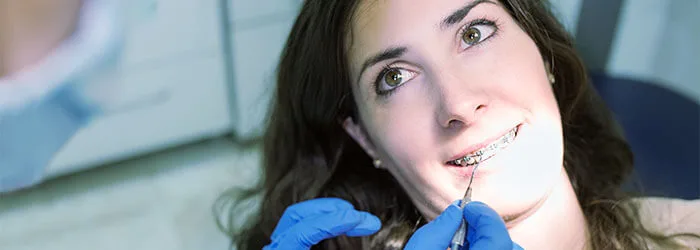
If you or your child is considering getting braces, then why not use our easy step Q&A guide to see whether the time is right:
Do I Need Braces?
A dentist usually recommends braces to improve the patient's physical "orofacial" appearance. Through orthodontic treatment, problems like crooked or crowded teeth, overbites, underbites, incorrect jaw position and disorders of the jaw joints are corrected.
When is the right time for braces?
Patients with orthodontic problems can benefit from treatment at nearly any age. An ideal time for placement of braces is between 10 and 14 years of age, while the head and mouth are still growing and teeth are more conducive to straightening. However, because any adjustments in facial appearance can be traumatic to a child during these sensitive years, parents should discuss the matter with their children before braces are applied. And braces aren't just for kids. More and more adults are also wearing braces to correct minor problems and to improve their smiles.
Braces: Not Just for Kids Anymore
Many people think of braces as a teenage rite of passage, but more adults are taking advantage of the opportunity to improve their appearance and oral health by getting braces.
Teeth can be moved and straightened at any age, and the benefits go beyond cosmetic. Crooked or crowded teeth or a misaligned bite can make thorough teeth cleaning more difficult, which increases the risk of tooth decay and gum disease. Also, a misaligned bite can interfere with speaking and can even lead to jaw problems.
Because an adult's facial bones are no longer growing, the same treatments may take longer in adults than in children. Also, certain types of tooth and jaw corrections may not be possible for adults with braces alone. Other types of orthodontic appliances or procedures may be needed to achieve the desired result.
What kind of braces will I wear?
Your dentist will know what appliance is best for your particular problem, but the patient often has a choice. Braces generally come in three varieties. The most popular type are brackets, metal or plastic, that are bonded to teeth and are far less noticeable. The "lingual" type of braces consists of brackets that attach to the back of the teeth, hidden from view. Bands are the traditional type that cover most of your teeth with metal bands that wrap around the teeth. All use wires to move the teeth to the desired position.
No matter what your age, you can choose braces that are inconspicuous or obvious. If you want your braces to be subtle, ask your dentist about attaching the brackets to the back of the tooth, rather than the front. Or, if you have brackets attached to the front of each tooth, they are available in clear or tooth-coloured versions. But you can make a statement with your braces, too. You can choose brackets in your school colours and brackets are available in different shapes, such as hearts and footballs.
How long will I have to wear them for?
That depends upon your treatment plan. The more complicated your spacing or bite problem is, and the older you are, the longer the period of treatment, usually. Most patients can count on wearing full braces between 18 and 30 months, followed by the wearing of a retainer for at least a few months to up to two years to set and align tissues surrounding straightened teeth. Some patients may have to wear a permanent retainer if you do not want your bite to return to the way it was.
Will treatment be uncomfortable?
The interconnecting wires are tightened at each visit, bearing mild pressure on the brackets or bands to shift teeth or jaws, gradually into a desired position. Your teeth and jaws may feel slightly sore after each visit, but the discomfort is brief. Keep in mind also that some teeth may need to be extracted to make room for teeth being shifted with braces and for proper jaw alignment.
What is cost of braces?
These days, affording braces is possible without breaking the bank. But it's important to take care of dental braces in order to get the most from your investment. The cost of braces varies depending on the extent of work needed, but the total can range from about £219 (at local NHS) to more than £5,000. Some dental insurance plans will cover part of the cost, and some will not cover any.
Ask your dentist to help you find an orthodontist who takes your insurance, and you'll have a better chance of getting the best deal on braces. Also check with your health benefits administrator about using money from a flexible spending account or health savings plan to make up any differences in cost that aren't covered by insurance.
Following a consistent oral care routine as recommended by your dentist will help keep your teeth and gums healthy and keep your braces in good condition while reducing the risk of added expenses from brackets or wires that are damaged or broken. Cleaning your teeth will take extra time, but it's worth the effort. Keep in mind that you can clean your teeth with braces more effectively if you use specialized products.
Who will provide my orthodontic treatment?
Your family general dentist is responsible for coordinating your dental treatment, and this could encompass any orthodontic treatment plan, including diagnosis, examinations and some orthodontic procedures. Your dentist may, however, refer you to an "orthodontist"—a specialist trained in the development, prevention and correction of irregularities of the teeth, bite and jaws and related facial abnormalities.
Related Articles
Sign Up
for expert advice and exclusive offers





